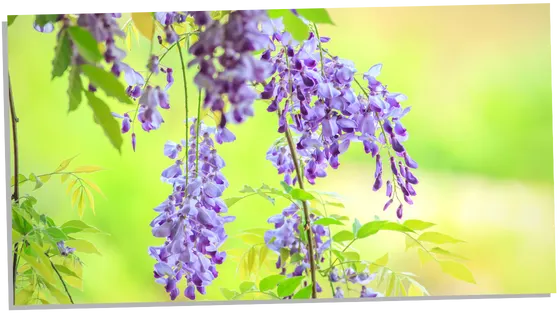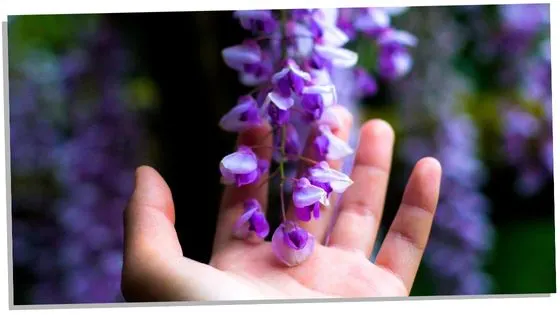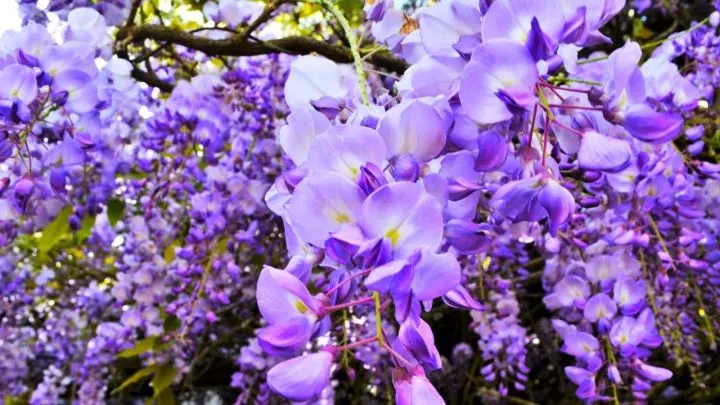To continue with the spiritual symbolism of some of the most exquisite flowers, today I am going to talk about the wisteria symbolism.
Wisteria is a beautiful flowery plant whose flowers grow in the shape of a falling cascade, and to be honest, and it’s a real wonder to be looking at it.
I have seen wisteria plants a few times in my life, and I was amazed at their beauty every time.
Wisteria has a powerful spiritual symbolism in many world cultures, but especially in the South Eastern area.
Wisteria has spiritual meanings in the Japanese culture, in Feng Shui and Buddhism, and in the Chinese culture.
Planting wisteria around your house can bring certain energetic benefits as wisteria has a rich spiritual symbolism.
The same goes for tattooing wisteria on your body or giving someone a piece of wisteria.
Thus, let’s explore together a few facts about wisteria and the main spiritual meanings related to wisteria symbolism.
About Wisteria
Wisteria was initially only specific to the Eastern side – Japan, China, and a few countries around that area.
When its beauty was noticed, the wisteria was brought and planted in Europe and the United States as well; however, it is still a rare plant.
Wisteria was brought into Europe for the first time in 1816, and its name was given by the botanist Thomas Nuttall, who wanted to name it “wistaria” in memory of anatomy and anthropology professor Dr. Caspar Wistar.
Unfortunately, this did not go according to plan because the flower’s name was misunderstood and ended up being called “wisteria.”
There are currently about 20 species of wisteria around the world, and the main colors in which this flower can be found are: pink, purple, blue, and white.
Wisteria is considered a plant, but its looks make it seem like a tree. Its special appearance has contributed to its rich and complex spiritual symbolism.
Thus, if you’re passionate about the spiritual symbolism of flowers or you love wisteria, let’s look at the main 15 spiritual meanings and associate it has.
The Spiritual Meanings of Wisteria
#1. Love & romantic feelings

Due to its sweet and gentle appearance, pink wisteria symbolizes love and romantic feelings.
Gifting someone pink wisteria can be a hint that you have feelings towards that person.
However, be mindful of the fact that in Japanese culture, blue wisteria symbolizes rejection in love due to the famous Kabuki drama “Fuji Musume,” released in 1820.
In this play, a woman waits for her lover under a wisteria vine and falls completely in love with him.
Unfortunately, her love is not reciprocated, and she is rejected and left heartbroken. Thus, in Japanese culture, the blue wisteria has become a symbol of pain and rejection.
If you want to show someone that you love them by gifting them wisteria, make sure the wisteria is pink.
#2. Sadness
Because of its falling shape – resembling the “crying willow,” wisteria also symbolizes sadness.
If you look at a wisteria plant closely, you will realize that it kind of looks like it is “crying.”
This meaning also comes from Korean culture, in which the legend about wisteria is around two sisters who loved the same man.
Because they did not want to compete with each other for his love, they decided to commit suicide together.
It is said that one of them became the branches of the wisteria, and the other one became the falling flowers of the wisteria.
Thus, one of the main wisteria meanings is sadness and sacrifice.
#3. Welcoming vibes
In some world cultures, the wisteria is used as a welcoming omen. If you want your house to be more welcoming, you can plant wisteria around it, or if you want to say “welcome” to someone in a completely unique manner, you can gift them a branch of wisteria.
The blue and white wisteria are usually the types of wisteria which are considered to symbolize a warm “welcome.”
#4. Devotion

Because of how wisteria is depicted in Japanese and Korean culture, this flower oftentimes symbolizes devotion.
Blue and white wisteria gifted to someone symbolize “I am devoted to you.”
The meaning of devotion is also related to wisteria’s meaning in Buddhism, where wisteria is used in temples for worship and prayer.
As worship and prayer are associated with devotion, wisteria has become a symbol of all these.
You can offer someone wisteria if you wish to let that person know that you care about them and their wellbeing.
#5. Youth
White and blue wisteria oftentimes symbolize youthfulness and energy. This meaning comes especially from the Chinese culture and is mainly related to how wisteria has been interpreted in this culture.
Here, wisteria symbolizes youth, playfulness, and energy because the unique way in which wisteria looks has been interpreted differently.
Here, the falling branches and flowers are seen as “playing” with each other rather than “crying.”
#6. Spirituality
White wisteria is a symbol of spirituality. It is highly used in Buddhism and Feng Shui to be put in temples and houses where the owner desires to attract High Vibrations and pure energies.
In Buddhism, wisteria is oftentimes used as an offering, and in Feng Shui, it is believed that it can make you become a more spiritual person if you put it in your house.
#7. Purity & Innocence
Another strong meaning of white wisteria is related to purity and innocence. This meaning is also related to its symbolism regarding youth and playfulness.
It also stems from how the white wisteria looks. The white wisteria looks truly heavenly, and it is oftentimes described as “angel wings.”
Thus, the white wisteria has become a symbol of purity and innocence.
#8. New Beginnings

One of the main spiritual meanings of wisteria is related to new beginnings. The white and pink wisteria are believed to symbolize this through all their other meanings related to youth and playfulness.
#9. Encouragement
Blue and purple wisteria is also seen as a symbol of encouragement. Wisteria has become a symbol of resilience in Japanese culture due to the abovementioned Kabuki play.
Gifting someone wisteria can be a way of saying, “Be strong!” or “I believe in you.”
When someone dear to you is going through a rough time, a branch of wisteria can be seen as a form of encouragement.
#10. Resilience
In relation to the meaning mentioned before, resilience is also worth mentioning regarding the broad wisteria symbolism.
Because in the Japanese Kabuki play that made wisteria famous, the woman endures the pain with bravery and resilience, wisteria has also become a symbol of resilience.
Thus, if you receive this plant as a gift, it could be because the person giving it to you believes you are a very resilient person, and it is acknowledging you for that.
#11. Luck
In Feng Shui, the symbolism of wisteria also involves good luck and prosperity. For this reason, some Feng Shui practitioners hang wisteria around houses.
It can be wisteria branches, or it can be wisteria paintings and objects with wisteria decoration.
#12. Longevity

In Chinese culture, wisteria has a strong symbolism related to longevity.
Wisteria plants don’t wither very easily and are also a symbol of youth and playfulness.
Planting wisteria around your house symbolizes longevity, prosperity, and positive energy.
#13. Prayer
In Buddhism, wisteria symbolizes prayer and meditation. Wisteria is used in temples, and it’s a symbol of worship, devotion, spirituality, and pure feelings.
Wisteria is perfect if you’re looking for a flower to hang around in your prayer space or to put on your altar because it draws positive energies and entities thus, your prayers can be heard more easily.
#14. Playfulness & adventure
Another spiritual meaning of wisteria is related to playfulness and adventure.
In Feng Shui and in Chinese culture, wisteria is generally used to bring more playfulness and child-like energy to a place or person.
This can be particularly useful if the energy of a place is quite grim, sad, or boring, or if someone is going through a depression or has lost their normal appetite for life.
Just like any other plant, wisteria can be charged with intention, and it’s a wonderful spiritual tool to be charged to bring more playfulness and adventure to someone’s life.
#15. Clinging to a person

In the Victorian Era, the wisteria was seen as a symbol of clinginess and feelings of desperation and attachment.
This was because the plant of wisteria oftentimes “clings” to trees and other plants, and its shape makes it seem as if it’s clinging to something.
Thus, this became a metaphor for emotional clinginess, and it was sometimes offered as a gift symbolizing attachment, not wanting to let go, deep love, and so on.
The Meaning of a Wisteria Tattoo
A wisteria tattoo can have multiple meanings, but the main ones are:
#1. Prayer & hope
A wisteria tattoo can oftentimes symbolize that the person is religious and that they have a strong relationship with the Divinity.
Sometimes, a wisteria tattoo can mean that you wish to have your prayers taken into account and answered.
This applies especially to the white wisteria tattoo.
#2. Grace and reverence
Similar to the meaning of prayer, a wisteria tattoo – especially a blue one- can mean that the person has a strong relationship to the Divinity but also that they are learning grace and reverence.
Learning grace and reverence, in this case, means praying with faith but also accepting the Divine Will and the Divine answer to your prayers – or learning how to be humble.
#3. Spirituality

A wisteria tattoo can also symbolize spirituality – the fact that the person has started their spiritual journey and has only recently started on their spiritual path.
A white or blue wisteria tattoo can symbolize “I have taken the first step on my spiritual path, and I am advancing with grace and reverence.”
#4. Romance
A pink wisteria tattoo can symbolize love and romance. It’s the type of tattoo that couples can have done together – as a symbol of their relationship, loyalty, and love.
Also, when a person is in love, they can choose a pink wisteria tattoo to show and profess their love to the universe.
#5. Sensuality
Another meaning of a wisteria tattoo – mainly pink or purple wisteria, can be sensuality or sexual love.
This tattoo again can be done in couples, or it can be done by a person who wishes to express that they are very sensual and sexual, and even to attract more of that energy into their lives.
#6. Playfulness
A wisteria tattoo can also symbolize playfulness, youth, and child-like energy.
A person who wishes to remain a child in their soul or to maintain their youthful energy can sometimes get a wisteria tattoo to symbolize that.
This applies more to pink, purple and blue wisteria, as the white one is more related to the spiritual meanings of wisteria symbolism.
#7. Elegance

A white or purple wisteria tattoo can also symbolize elegance and luxury.
These colors generally symbolize elegance, especially when it comes to a wisteria tattoo – as these tattoos can look quite exquisite and elegant – making you think of the hidden beauties of the Middle East.
RELATED: The Surprising Symbolism Of Daffodils: An Eye Opening Guide
When to gift someone wisteria
Wisteria has a strong and rich symbolism; thus, offering someone a piece of wisteria can mean a lot of things.
Let’s look at the main meanings of offering someone wisteria as a gift and what each color symbolizes in this context.
#1. Pink wisteria gift
A pink wisteria can be offered as a gift at a wedding or when you have romantic feelings for someone.
Also, a pink wisteria can be offered as a gift when someone has given birth to a baby girl.
As pink wisteria also symbolizes sensuality, you can offer it as a gift to someone you are sexually attracted to, as a symbol of lust.
#2. White wisteria gift

White wisteria as a gift can symbolize encouraging someone to go down the spiritual route or to discover their spirituality.
Also, it can show devotion and platonic/pure love towards that person.
#3. Blue/purple wisteria as a gift
Blue/purple wisteria as a gift can symbolize more feelings of sadness and fear that you have lost someone.
If you want to tell someone you regret losing them, blue or purple wisteria can be a good way to do so.
We look forwards to reading your opinion about this article in the comments section below.
Also, if you happen to know more spiritual meanings of the wisteria symbolism, share your knowledge with us!
❤️ Related:
Alexandra, the head author at Subconscious Servant is a Psychologist, Reiki Therapist, and writer. She loves writing about any topic from Applied Psychology, Metaphysical and Spiritual healing, hoping that people on a spiritual, self-discovery journey will find guidance and light through her articles. If you want to read more about Alexandra, visit her full author bio here.


